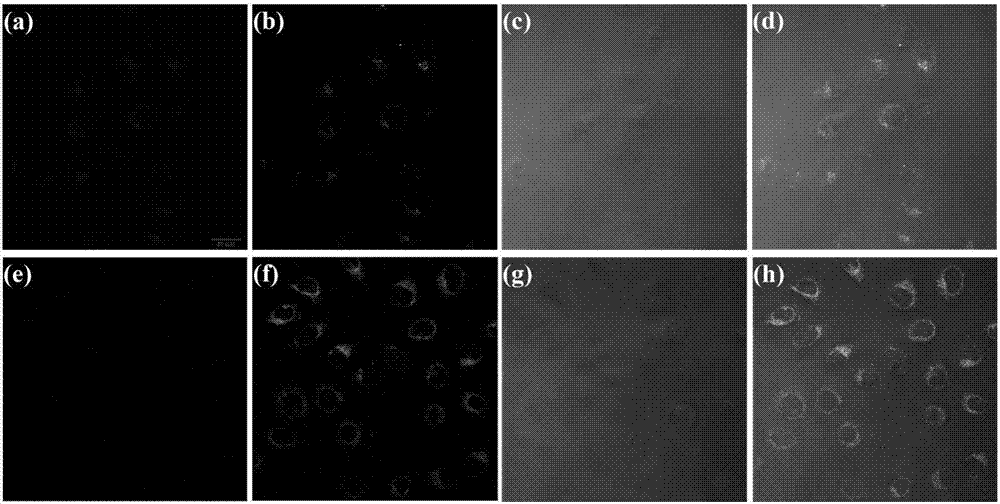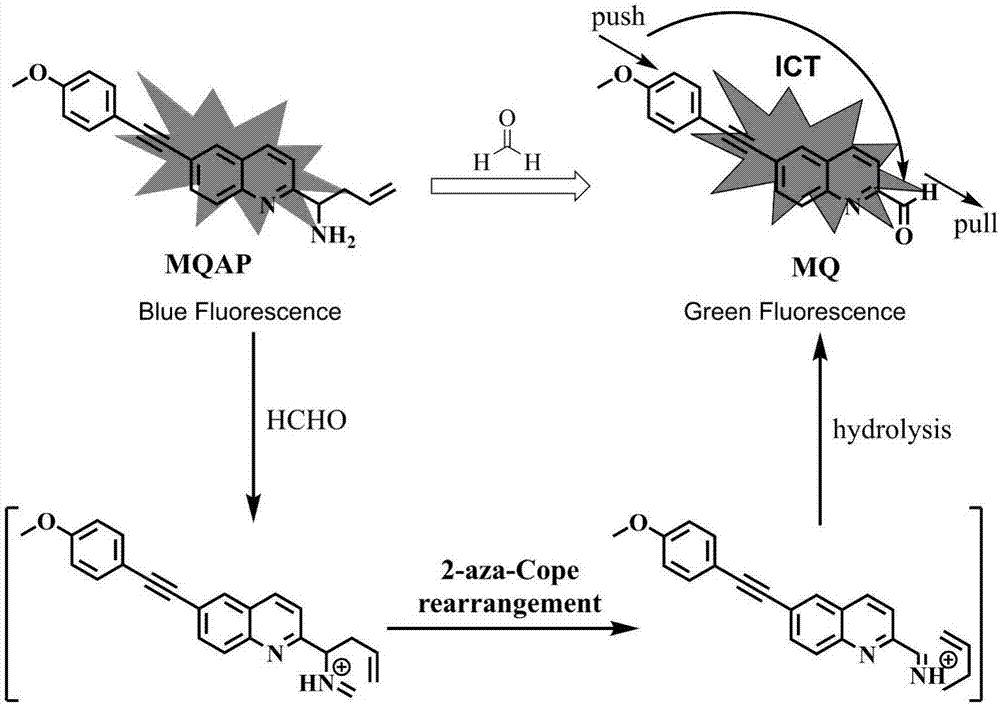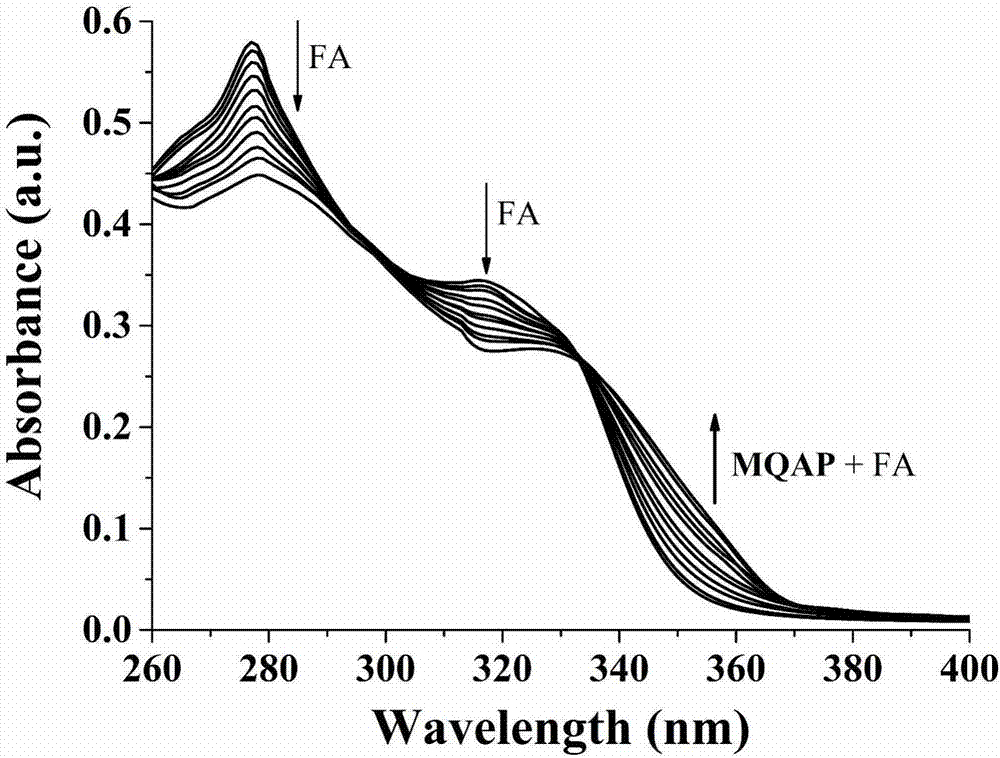Ratio-type two-photon formaldehyde fluorescent probe, preparation method therefor and use of ratio-type two-photon formaldehyde fluorescent probe
A fluorescent probe and two-photon technology, applied in fluorescence/phosphorescence, chemical instruments and methods, luminescent materials, etc., can solve the problems of few reports of two-photon fluorescent probes, and achieve simple structure, specific selectivity, and simple operation Effect
- Summary
- Abstract
- Description
- Claims
- Application Information
AI Technical Summary
Problems solved by technology
Method used
Image
Examples
Embodiment 1
[0034] Embodiment 1: the synthesis of fluorescent probe molecule MQAP
[0035] Dissolve 288.09mg (1mmol) of compound MQ, 677.38mg (10mmol) of 25wt% ammonia water in methanol, stir and react at 0°C for 30min, then add 202mg of propenylboronic acid o-di-tert-alcohol ester after warming up to room temperature, and stir at 30°C Reaction for 24 hours; After the reaction, the reaction solution was rotary evaporated to remove the solvent to obtain a crude product, and the column chromatography was performed on 200-300 mesh silica gel, and the eluent was mixed with dichloromethane and methanol at a volume ratio of 10:1 to obtain the target product MQAP 148.12mg (0.45mmol), productive rate 45%;
[0036] The structural formula of the compound MQ is:
[0037]
[0038] 1 H NMR (600MHz, CDCl 3): δ8.07(d, J=8.5Hz, 1H), 8.00(d, J=8.7Hz, 1H), 7.96(d, J=1.3 Hz, 1H), 7.78(dd, J=8.7, 1.7Hz ,1H),7.51(d,J=8.7Hz,2H),7.46(d,J=8.5Hz,1H),6.90(d,J=8.7Hz,2H),5.87–5.74(m,1H),5.16 (dd,J=17.1,1.1Hz...
Embodiment 2
[0039] Example 2: Two-photon testing of fluorescent probe molecules
[0040] Fluorescent probe of the present invention is dissolved in DMSO and makes the mother liquor of 1mM, utilizes two-photon testing technique, test the two-photon absorption cross section of (MQ) after fluorescent probe molecule (MQAP) and fluorescent probe molecule react with formaldehyde, from Figure 4 It can be seen that the maximum absorption cross sections of the fluorescent probe molecules before and after the reaction with formaldehyde are 185 and 274 GM respectively, and the two-photon excitation wavelengths are both at 720 nm.
Embodiment 3
[0041] Example 3: Cytotoxicity Test
[0042] The MTT (3-(4,5-dimethylthiazole-2)-2,5-diphenyltetrazolium bromide) experiment was based on the reported articles to do some cytotoxicity tests. Add 0, 10, 20, and 30 μM fluorescent probes to the same batch of cells, and the conditions are 37 ° C, 5% CO 2 Incubate in a cell incubator for 24 hours, according to the formula of cell viability: cell viability% = OD 570 (sample) / OD 570 (control group)×100, the cell survival rate can be calculated ( Figure 5 ). from Figure 5 We can see that, when the concentration is 10 μM, the cell survival rate is still about 98%, which shows that the fluorescent probe of the present invention has no toxic effect on cells, so it can be used to detect formaldehyde in cells.
PUM
 Login to View More
Login to View More Abstract
Description
Claims
Application Information
 Login to View More
Login to View More - R&D
- Intellectual Property
- Life Sciences
- Materials
- Tech Scout
- Unparalleled Data Quality
- Higher Quality Content
- 60% Fewer Hallucinations
Browse by: Latest US Patents, China's latest patents, Technical Efficacy Thesaurus, Application Domain, Technology Topic, Popular Technical Reports.
© 2025 PatSnap. All rights reserved.Legal|Privacy policy|Modern Slavery Act Transparency Statement|Sitemap|About US| Contact US: help@patsnap.com



